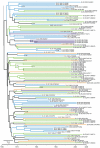Reviewing the history of HIV-1: spread of subtype B in the Americas
- PMID: 22132104
- PMCID: PMC3223166
- DOI: 10.1371/journal.pone.0027489
Reviewing the history of HIV-1: spread of subtype B in the Americas
Abstract
The dispersal of HIV-1 subtype B (HIV-1B) is a reflection of the movement of human populations in response to social, political, and geographical issues. The initial dissemination of HIV-1B outside Africa seems to have included the passive involvement of human populations from the Caribbean in spreading the virus to the United States. However, the exact pathways taken during the establishment of the pandemic in the Americas remain unclear. Here, we propose a geographical scenario for the dissemination of HIV-1B in the Americas, based on phylogenetic and genetic statistical analyses of 313 available sequences of the pol gene from 27 countries. Maximum likelihood and bayesian inference methods were used to explore the phylogenetic relationships between HIV-1B sequences, and molecular variance estimates were analyzed to infer the genetic structure of the viral population. We found that the initial dissemination and subsequent spread of subtype B in the Americas occurred via a single introduction event in the Caribbean around 1964 (1950-1967). Phylogenetic trees present evidence of several primary outbreaks in countries in South America, directly seeded by the Caribbean epidemic. Cuba is an exception insofar as its epidemic seems to have been introduced from South America. One clade comprising isolates from different countries emerged in the most-derived branches, reflecting the intense circulation of the virus throughout the American continents. Statistical analysis supports the genetic compartmentalization of the virus among the Americas, with a close relationship between the South American and Caribbean epidemics. These findings reflect the complex establishment of the HIV-1B pandemic and contribute to our understanding between the migration process of human populations and virus diffusion.
Conflict of interest statement
Figures




References
-
- Osseo-Asare AD. The African Aids Epidemic: A History. Social History of Medicine. 2007;20:401–402.
-
- Rambaut A, Posada D, Crandall KA, Holmes EC. The causes and consequences of HIV evolution. Nature reviews Genetics. 2004;5:52–61. - PubMed
Publication types
MeSH terms
LinkOut - more resources
Full Text Sources
Medical

